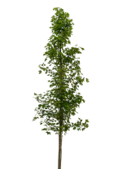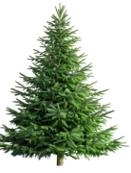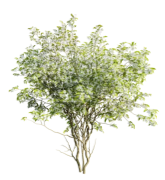| Red Maple - 2 gallon pot |
- Reaches 25 metres high.
- Trunk grows up to 1 metre in diameter.
What you need to know to grow red maple

- Moisture: grows best in wet soils, but tolerates some drought.
- Soil: grows in acidic, loamy, sandy, silty and clay soils.
- Shade: grows best in full sun.
- Caution: red maples can be weak and are prone to cracking bark and overcrowding branches.
Trees are susceptible to damage during storms. Light pruning can help protect the tree.
Fun facts about red maple
- Red maple trees live up to 100 years.
- Red maple sap can be used to make maple syrup.
|
| Bur Oak - 2 gallon pot |
- Medium-large tree, reaching 15 to 30 metres tall.
- Trunk reaches 60 to 120 centimetres in diameter.
- Usually grows tall with a straight trunk. In shallow soil, may be smaller with a twisted trunk and gnarled branches
What you need to know to grow bur oak
- Moisture: tolerates a wide variety of moisture conditions.
- Soil: grows in a variety of soils.
- Shade: grows best in full sun but tolerates moderate shade.

Cautions:
- Space: bur oaks have deep roots, so avoid planting near underground pipes.
- Disease: oak wilt is caused by an invasive fungus that has been found in Southern Ontario. To minimize the risk of oak wilt, save pruning for before April and after July, when beetles thought to transport the fungus are less active.
Note: bur oaks can survive transplanting and grow well in cities.
Fun facts about bur oak
- Bur oaks have very thick bark that helps them survive forest fires.
- Their deep roots help them tolerate drought.
|
| Sycamore - 2 gallon pot |
- Large tree reaching 35 metres tall.
What you need to know to grow sycamore
- Moisture: grows best in moist soils and tolerates seasonal flooding.
- Soil: grows best in rich soils and tolerates heavy clay.

- Shade: can grow in part shade or full sun.
Cautions:
- Root system: Like many willow species, sycamore has a shallow, fibrous root system that can get into septic beds and sewage pipes as it searches for water size:
- Give sycamore trees plenty of space to grow as they can be one of the largest (height and width) broadleaf trees in eastern North America, especially on rich floodplains
Fun facts about sycamore
- Ontario’s largest recorded sycamore tree, near Alvinston, was 263 centimetres in diameter at breast height.
|
| Red Oak - 2 gallon pot |
- Reaches 20 to 30 metres high.
- Thick trunk (up to 30 to 90 centimetres in diameter).
What you need to know to grow red oak
- Moisture: tolerates a variety of moisture levels.
- Soil: grows in a variety of soils.
- Shade: grows best in full sun but can tolerate some shade.

Cautions:
- Space: Red oak needs room to grow. It will not grow well if near other trees.
- Disease: oak wilt is caused by an invasive fungus that has been found in Southern Ontario. To minimize the risk of oak wilt, save pruning for before April and after July, when beetles thought to transport the fungus are less active.
Fun facts about red oak
- Red oak trunks can sometimes reach more than 120 centimetres in diameter.
- Sometimes dead leaves stay on oak trees, even in the winter.
|
| Tulip Tree - 2 gallon pot |
- Large, fast-growing tree.
- Reaches 25 to 35 metres in height.
- Trunk reaches 50 to 160 centimetres in diameter.
What you need to know to grow tulip trees
- Moisture: need a lot of moisture during summer.
- Soil: grow best in sand and sandy loam.
- Shade: need full sun.

Cautions:
- Tulip trees need deep, rich, moist soil. They are fast-growing with roots that grow deep and spread widely.
Fun facts about tulip trees
- Tulip trees are named for their tulip-shaped flowers.
- Tulip trees begin flowering after they are 15 years old.
- This species is fast-growing and, under ideal conditions, long-lived.
|
| White Spruce - 2 gallon pot |
- Usually grows to be 24 metres tall.
- Under ideal conditions can grow to more than 30 metres tall.
- Trunk can reach about 60 centimetres in diameter.
What you need to know to grow white spruce
- Moisture: tolerates a range of moisture levels.
- Soil: can grow in almost any soil type.

- Shade: tolerates shade.
Caution:
- White spruce is sensitive to frost damage when young and should be planted in a protected area.
Fun facts about white spruce
- White spruce usually lives between 250 and 350 years but trees up to 1,000 years have been documented.
- White and black spruce are difficult to tell apart, but white spruce has larger cones and longer needles than black spruce.
|
| White Pine - 2 gallon |
- Reaches 20 to 40 metres tall.
- Trunk reaches 60 to 140 centimetres in diameter.
What you need to know to grow eastern white pine
- Moisture: tolerates different moisture levels.
- Soil: grows best in sand or sandy loam but will grow in any soil type.

- Shade: grows best in full sun but young trees can tolerate some shade.
Note: Eastern white pine trees grow quickly and are ideal for blocking unsightly views or creating shade for your house.
Caution: eastern white pine can become lopsided in areas with high wind exposure.
Fun facts about eastern white pine
- Eastern white pine is the provincial tree of Ontario.
- In colonial times, these tall trees were used to make masts for British Royal Navy ships
|
| Eastern Redbud -1 gallon |
- Reaches about 6 to 9 metres in height
- Trunk reaches about 20 to 25 centimetres in diametre.
What you need to know to grow eastern redbud
Fun facts about eastern redbud trees:
-
Eastern redbuds flower early, have edible blossoms and seeds, and have relatively few pests.
-
They also have a unique connection to the legend of Judas Iscariot, being sometimes called the Judas tree.
|
| Service Berry - 2 gallon pot |
- Reach a height of 15 to 30 feet, with a spread of 15 to 25 feet
What you need to know to grow a service berry
-
Moisture: Young serviceberry trees need regular watering to help them establish roots; Established trees are moderately drought-tolerant, but should be watered during prolonged dry periods. Avoid overwatering, as soggy soil can be problematic.
-
Soil: prefer moist, well-drained soil, and are adaptable to a wide range of soil types; avoid waterlogged sites; A slightly acidic to neutral pH (6.0-7.8) is ideal. waterlogged sites; A slightly acidic to neutral pH (6.0-7.8) is ideal.
-
Shade: Serviceberries need at least 4 hours of direct sunlight daily, but can tolerate part shade; more sunlight generally leads to better fruit production.
Fun Facts about Service Berry Trees
-
Offer a beautiful display of blooms in spring, edible fruits in summer, and vibrant fall foliage. They also play a vital role in supporting wildlife, attracting pollinators and birds.
|
| River Birch - 2 gallon |
|
River birch is a medium to tall tree, growing 60-80 feet at maturity and about 40 wide. Trees typically live 50 -75 years. The trunk typically grows about 2 feet in diameter but occasionally will be much wider.
What you need to know to grow a River Birch
-
Moisture: prefers moist soil and should be watered regularly, especially during the summer months.
-
Soil: prefers moist, well-drained soil that is slightly acidic (pH between 5.0 and 6.4); it tolerates a wide range of soil types, including clay, loam and sand but thrives in moist slightly acidic soils.
-
Shade: thrives in full sun to partial shade, with at least six hours of sunlight daily.
Fun facts about River Birch
-
Known for their distinctive, peeling bark, often revealing shades of pink, tan, and brown.
-
They are also a pioneer species, meaning they thrive in open areas and can improve soil conditions.
|










 abundant flowering, while partial shade can offer some protection in hot climates.
abundant flowering, while partial shade can offer some protection in hot climates. waterlogged sites; A slightly acidic to neutral pH (6.0-7.8) is ideal.
waterlogged sites; A slightly acidic to neutral pH (6.0-7.8) is ideal.